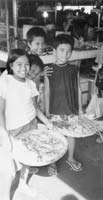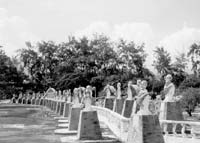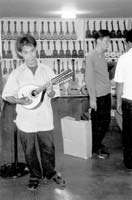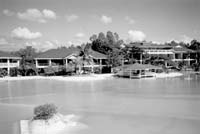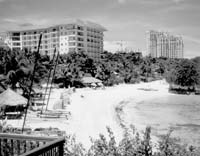Far Horizons » The Philippines: Cebu and Mactan
by Randy Keck, part 2 of 2 on the Philippines
The second portion of my recent visit to the Philippines focused on the island of Cebu, specifically on the area around Cebu City and adjacent Mactan Island, both rich in terms of historical significance.
In 1521 the famous explorer Magellan met his end at a battle on Mactan Island after incurring the wrath of local chieftain Lapu-Lapu, who had no tolerance for the explorer’s exploitative practices. A monument on Mactan commemorates the historical significance of that important battle.
During the early part of the era of Spanish reign, Cebu was the capital of the Philippines and was considered a province of Mexico.
Currently, Cebu is the most rapidly developing metro area of the country, with growth rates more than double the national average. As the only province openly opposed to the rule of President Marcos, for two decades Cebu suffered from severe economic isolation. Today Cebu is a major trading port, the most ethnically diverse region of the country and the favored locale for American expats with business interests in the Philippines. In slang parlance, Cebu is economically where “it’s happening” in the Philippines.
Touring Cebu
Our touring in Cebu included Cebu City, Mactan Island, Fort San Pedro, Basilica Minore del Santo Nino Church and Lapu-Lapu monument plus exploring a colorful hillside Taoist temple where several of us became hooked on local Ube (yam) ice cream bars, costing 12¢ each.
The following day, touring north of Cebu City, we visited a rustic ceramics factory in Liloan, woodcraft makers in Compostela (Puso), hanging rice artisans in Danao City and Celestial Gardens, where large statues of all popes are on display. We would have required at least one or two more full days of touring in Cebu to access more of the many attractions our limited time did not allow.
Cebu also provides easy access for day trips or longer excursions by large modern craft to Bohol, Negros and Leyte, large neighboring islands with a range of scenic and cultural offerings.
Guitars and more
My favorite excursion was to the Alegre Guitar factory where our tour revealed the intricate, time-consuming practices involved in making quality string instruments. A variety of exotic woods are used in the finer instruments, some of which must cure for up to three years. Later we were entertained, as the craftsmen just happened to also be skilled musicians.
So enthralled with the beauty, craftsmanship and sounds of these fine works of art, I was inspired to purchase a top-of-the-line mandolin featuring four types of woods, including black ebony and Brazilian rosewood, enhanced by mother-of-pearl inlay.
This unintended purchase by my musically challenged self is a creation of rare beauty with magical tones and was in my possession, including a hard case, for $150. Upon returning home, I determined its value at easily five times what I paid.
Mango mania
Present at every meal in Cebu was some form, and often several forms, of the beloved mango. Cebu mango is recognized as the best in the Philippines and perhaps the world. Fresh mango became an expected staple of our dining at all meals and luscious dried mango our overwhelmingly preferred snack.
We stopped at a mango products store, where I loaded up on stores of packaged dried mango for the trip home. The cost for these “fruit of the gods” packets was 30¢ each. Upon returning home and in a desperate effort to replenish supplies, I found the same packet from Cebu in a local health food store for $1.75. I am now considered a mangotarian, which is one who is constantly in search of all things mango and who has achieved the advanced state of awareness and full nurturance that only mango worship and devotion can provide. It would seem I’ve become a candidate for a mango cult.
Accommodating Cebu in style
Our small group was painlessly accommodated for two nights at the large-scale Shangri-La Mactan Island Resort (rack rates from $200 double, with packages available), about 20 minutes from the Cebu airport and 40 minutes from the bustling metropolis of Cebu City.
The Shangri-La had virtually every resort amenity imaginable, including a pleasant private beach, immaculate tropical landscaped grounds and three fine restaurants. While busy touring for most of our stay, we did have a chance to enjoy some of the resort’s amenities on our final day. I made good use of the excellent tennis facility, the beach and one of the resort’s large pools.
Fortunately, I had arranged to spend two extra days in Cebu at the end of our small group’s scheduled tour. This provided the opportunity to sample another Mactan Island property, Plantation Bay Resort & Spa in Marigondon (rack rates from $165 double; packages available).
While only possessing a tiny plot of actual beachfront, the resort has been developed around an appealing system of large, man-made lagoons rimmed with sand beaches and swaying palms and filled with warm, filtered seawater ideal for long, leisurely swims. Many of the resort’s rooms and cabanas either overlook or are built out over the lagoons.
At Plantation Bay I had a chance to fully relax and enjoy the facilities. These included the rustic but fun clay tennis courts and the relaxing Mogambo Springs Spa. I also had an opportunity to experience an exhilarating dive near an offshore island arranged with the excellent dive shop located at the resort.
Land of the nonstop smile
Certainly, one of the Philippines’ greatest resources is its overwhelmingly friendly people. Most speak English, are gregarious and helpful and seem to appreciate the importance of tourism to their nation’s economy. Americans tend to be treated extremely well, which is a bottom-line consideration for many contemplating visiting developing countries on an independent basis. This combination of friendliness, safety and excellent value makes the Philippines an increasingly user-friendly destination for visitors.
It is my intention to return to the Philippines on my own to explore some of its less-developed island treasures, particularly the island of Bohol, the ecotourism destination of Palawan and perhaps one or two smaller islands. My research clearly indicates that the timeless vision of the pristine South Pacific island is a dream still today attainable in the less-developed islands of the Philippines, and the beckon call is clear.
Cebu and Mactan contacts
• Shangri-La Mactan Island Resort; phone 800/942-5050, e-mail mac @shangri-la.com or visit www.shangri-la.com.
• Plantation Bay Resort & Spa, Cebu; phone (6332) 340-5900, fax (6332) 844-5030, e-mail rsvns@plantationbay.com or visit www. plantationbay.com.
• Philippine Tourism Office, 3660 Wilshire Blvd., Ste. 216, Los Angeles, CA 90010; phone 213/487-4525, e-mail pdotia@aol.com or visit www.thephilippinesnow.com.
• Rajah Tours International, 500 Sutter St., Ste. 906, San Francisco, CA 94102; phone 800/392-3345, e-mail contactus@rajahtours.com or visit www.rajahtours.com.
Randy was a guest of the Philippine Tourism Office and Philippine Airlines.

